More Babies
Courtesy of Scott Galloway, No Mercy/No Malice
Our species dates back 300,000 years. For most of that time, most humans lived to their early 30s, as a bad cut or broken bone was a death sentence. Around 1800, things changed: wealth, life expectancy, and the population all exploded. In the past two hundred years, per capita GDP has grown 15x; we now live twice as long as our great-grandparents, and our population is up eightfold — from 1 billion to 8 billion.
In 1798, Thomas Malthus predicted a global overpopulation apocalypse. It didn’t happen. When I was growing up, after a quadrupling of the population since Malthus, Paul and Anne Ehrlich penned a bestseller, The Population Bomb. The population has doubled again, but still … no apocalypse. It’s time to recognize that overpopulation isn’t a thing. It’s counterintuitive, but population density has no correlation with food insecurity. Poverty is the result of multiple factors: natural disasters, wars, poor agricultural infrastructure, and bad actors accumulating too much power. Climate change is a function of our energy and lifestyle choices, not our numbers.
We aren’t going to shrink our way out of climate change, income inequality, or any crisis. The solution is more. Specifically, more people who generate ideas that make the world more productive — ideas that let us do more with less. Stanford economist Charles Jones has shown that what generates prosperity is, ultimately, ideas — and ideas are the product of brains. More brains, more ideas.
However, we’re in danger of running out of ideas because, well … we’re running out of people.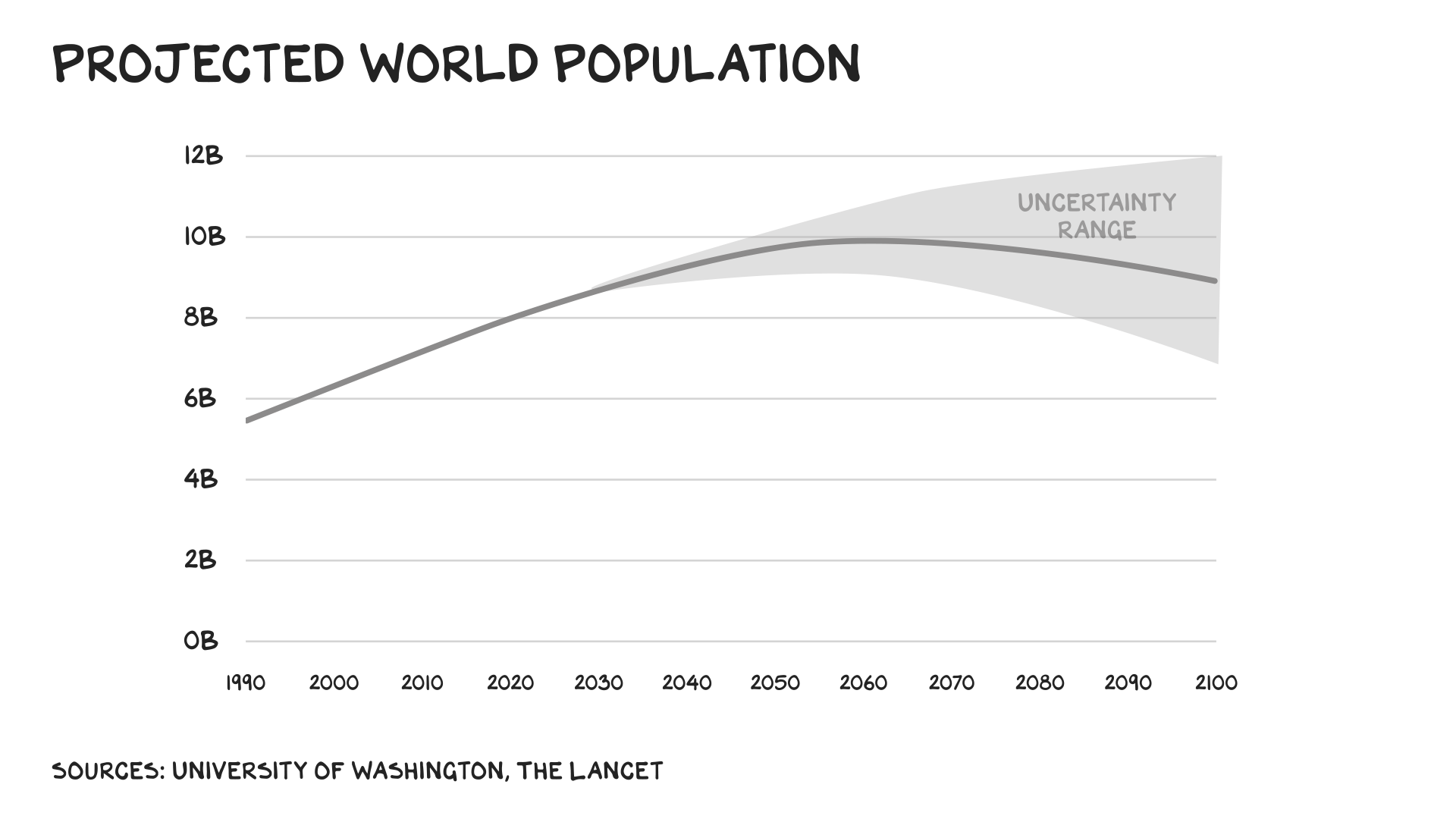
Stagnant
America’s population grew 0.4% last year — a slight uptick from 2021, which recorded the lowest growth rate in our history. China’s population fell by 850,000, its first decline in more than 60 years. One Chinese official said the nation is now in an “era of negative population growth.” It’s not alone: The populations of Japan, Germany, Italy, Greece, Portugal, and many Eastern European nations are shrinking.
Throughout human history, birth outperformed death; that’s about to change. Africa’s population continues to grow, but not enough to compensate for declines elsewhere. Researchers project the global population will peak in 2064 and then begin its retreat. More than 20 nations will see their populations shrink by 50%. The greatest threat to humanity isn’t climate change or thermonuclear war, but nothingness. Specifically, that our species will decide it should slowly and steadily fade to black.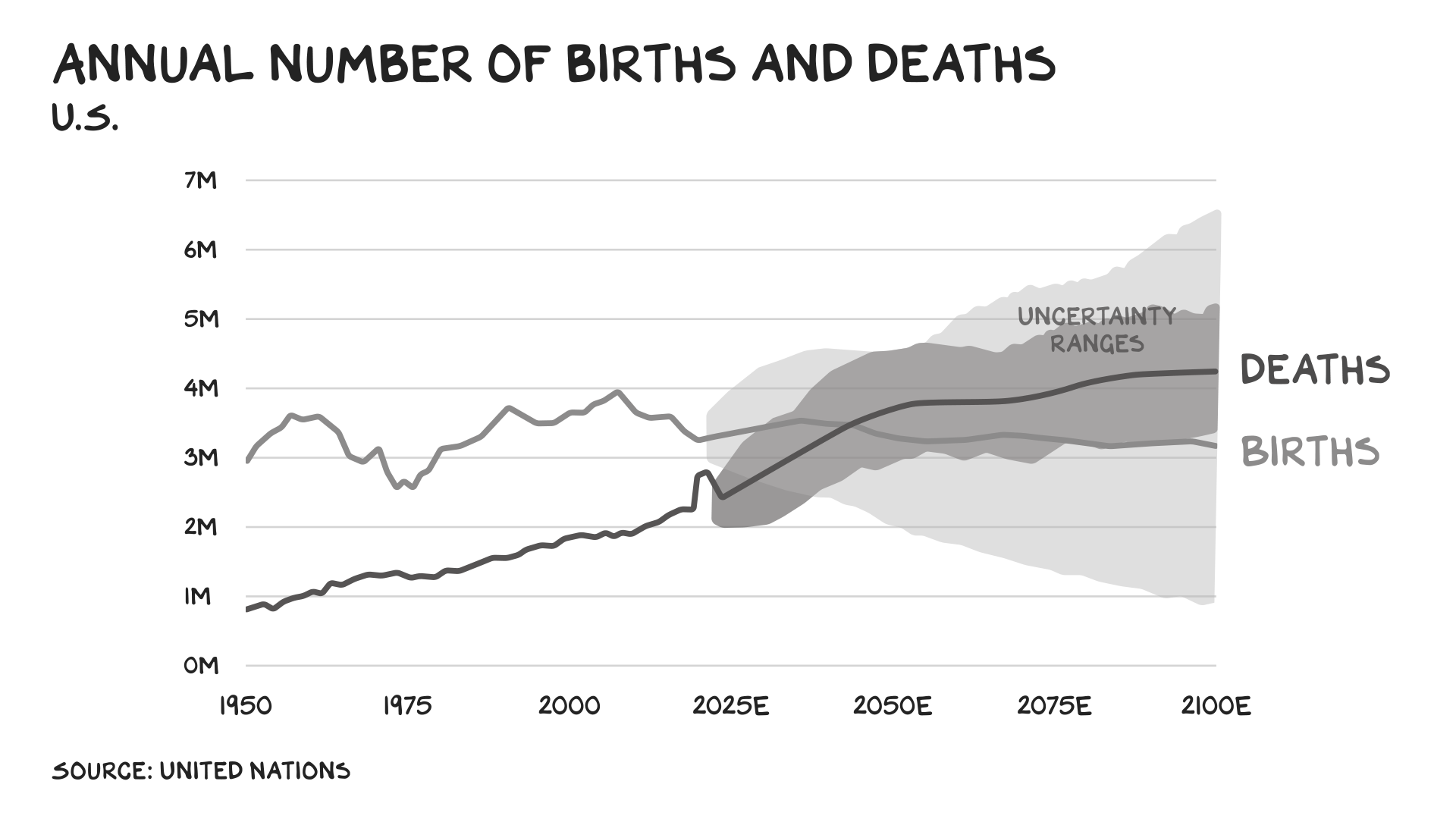
The Math Ain’t Mathin’
Fewer people means fewer brains and less labor — which means less innovation in solar panels and less carbon removed from the atmosphere. Also: fewer art shows, football matches, sleepaway camps, patents, proms, and bat-mitzvahs. Less of everything that makes us human. This presents a blunt and simple math problem. Globally, the number of people older than 80 is expected to increase sixfold by 2100. Meanwhile, the population of children 5 and younger will get halved. We’re facing not only a population decline, but also degradation — too many old people and not enough young people. To register the tectonic nature of this shift in our culture, imagine a world with six times as many (potential) grandparents and half as many grandkids. Thanksgiving becomes a dystopian scene from the 14th season of The Handmaid’s Tale — 12 seniors vying for the attention of the one 4-year-old.
As the population ages, it also becomes less productive. Why? Our economic productivity peaks in our 40s and declines from there.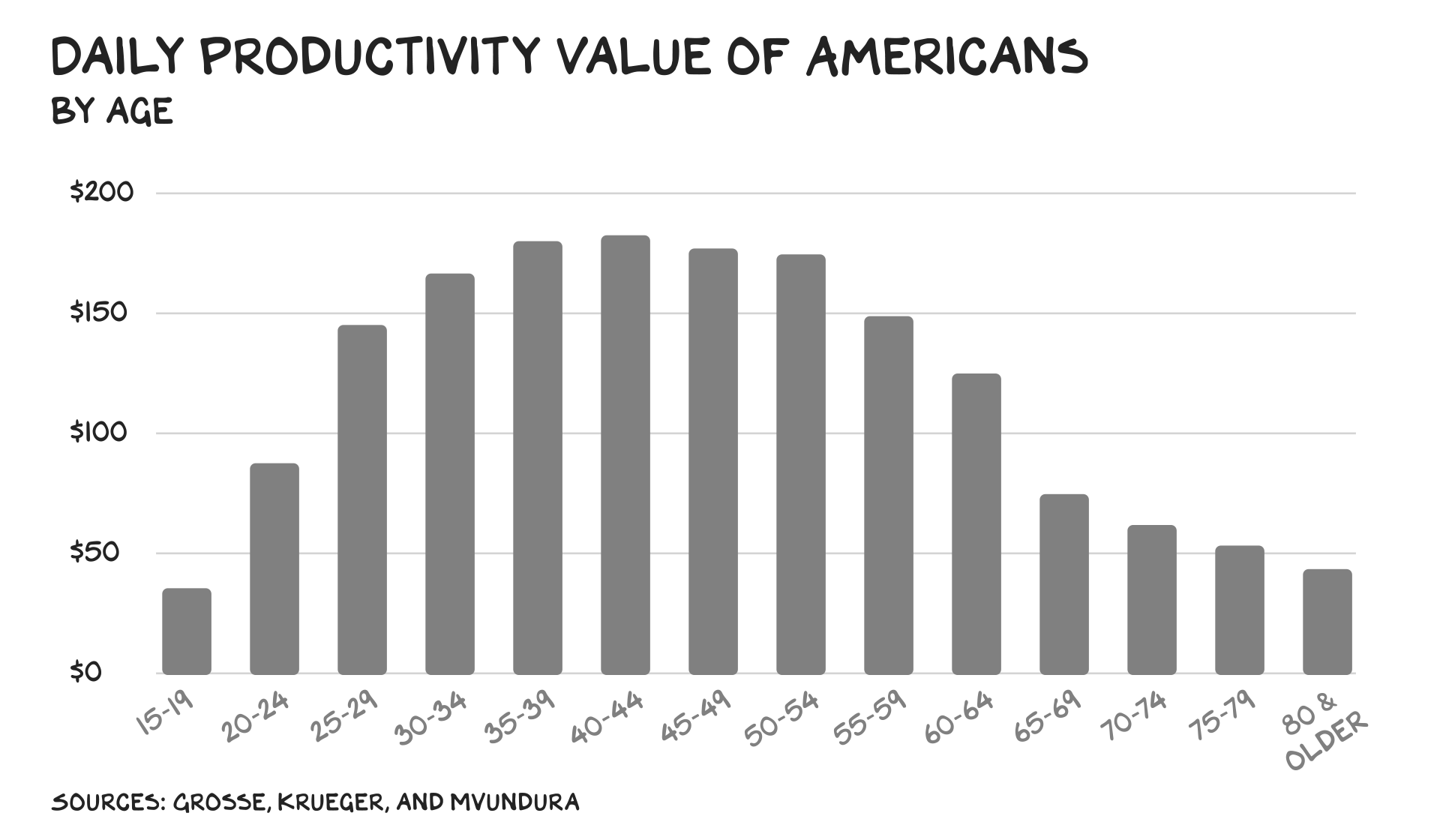
While being less productive, seniors also consume substantially more public resources. Though seniors as a cohort control huge amounts of wealth, most of them are dependent on Social Security and Medicare — the bottom 50% of boomer households own just 2% of boomer wealth. The U.S. median household income, including Social Security, for people 65 and older is just $47,620, the lowest of any age group. As a result, we spend 40% of our total tax dollars on people 65 and up, and that will increase to 50% by 2029. Nineteen percent of our GDP is allocated to a product young people hardly consume: health care.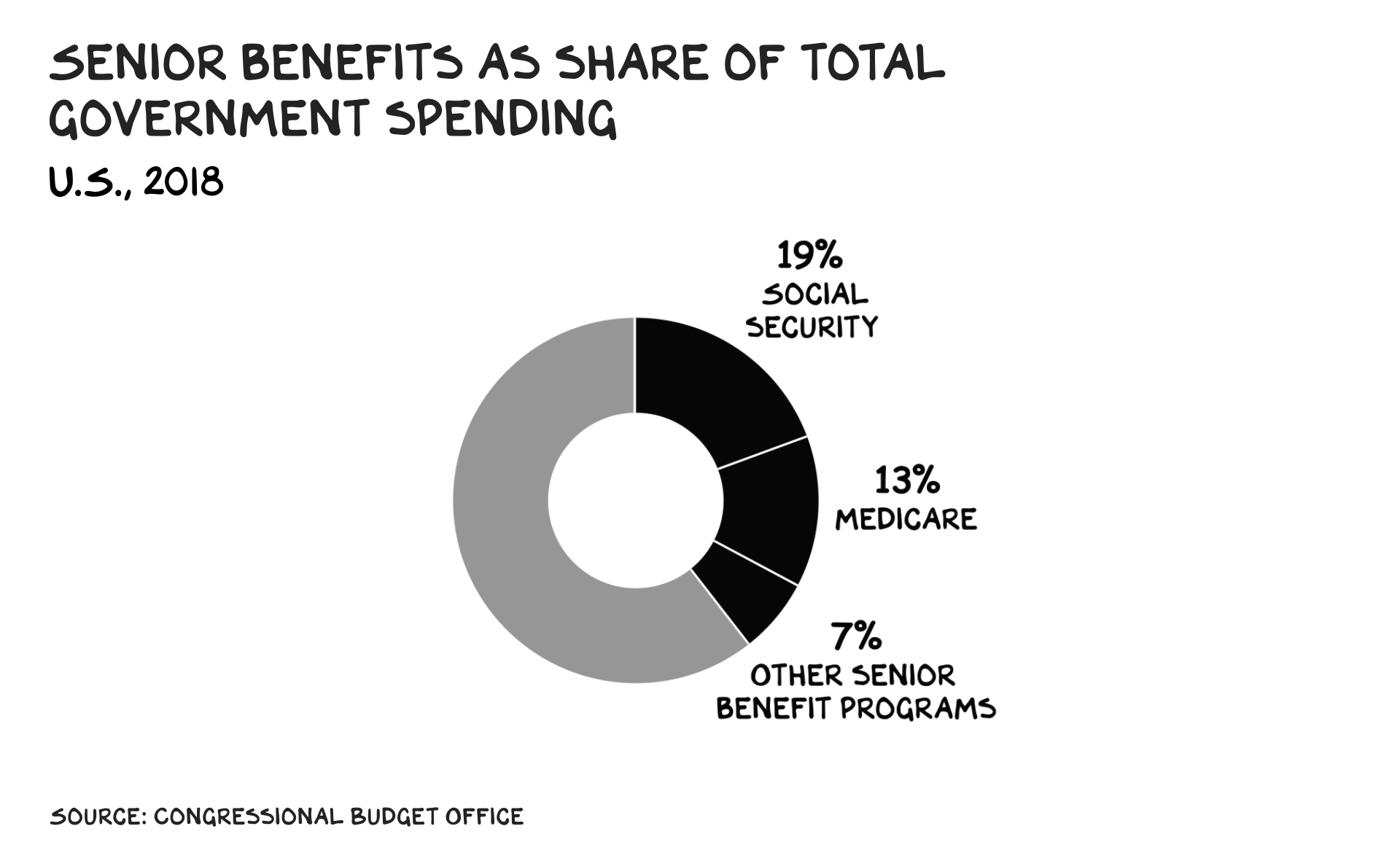
Band-Aids
In the U.S., one proposal is to change the balance between workers and retirees by extending our “working age” — raising Social Security eligibility to 70, and Medicare to 67. However, the Congressional Budget Office projects that by 2035, these changes would reduce annual outlays in these programs by just 4% and 5% respectively.
Another band-aid proposal is to means-test Social Security payments. That is, cut payments for rich people. Two problems: First, we effectively do this already through taxation. (Social Security benefits are subject to tax, which takes a much bigger bite from those with other sources of income.) Second, while we could go further and strike wealthy recipients from the rolls, there aren’t enough wealthy old people to make the change worthwhile. Three-quarters of Social Security payments go to seniors who make less than $20,000 per year, and 90% go to those making less than $50,000. So net-net, we’d save … between zero and 4% of benefit payments, depending on the cut-off.
Again, we aren’t going to shrink our way out of the problem. We have to grow out of it. At a national level, there’s a real solution: immigration. Immigrants are the lifeblood of business formation in America, and they’ve been responsible for half of our unicorns. Attracting, welcoming, and retaining ambitious people from abroad is the easiest way to get rich. Like many countries, we’ve politicized the issue, as humans are wired to distrust strangers. But let’s be clear: Welcoming immigrants has always been America’s superpower, full stop.
But that still won’t be enough. We also need home-grown solutions that encourage Americans to have more kids.
Operation Fertility
Net population growth requires a fertility rate slightly greater than two births per woman. Almost every developed nation is falling short of that. America’s fertility rate is 1.8; the average for high income countries, 1.7. We need more babies — born into stable homes, with supportive families, quality health care, and good schools. What some might call a nation.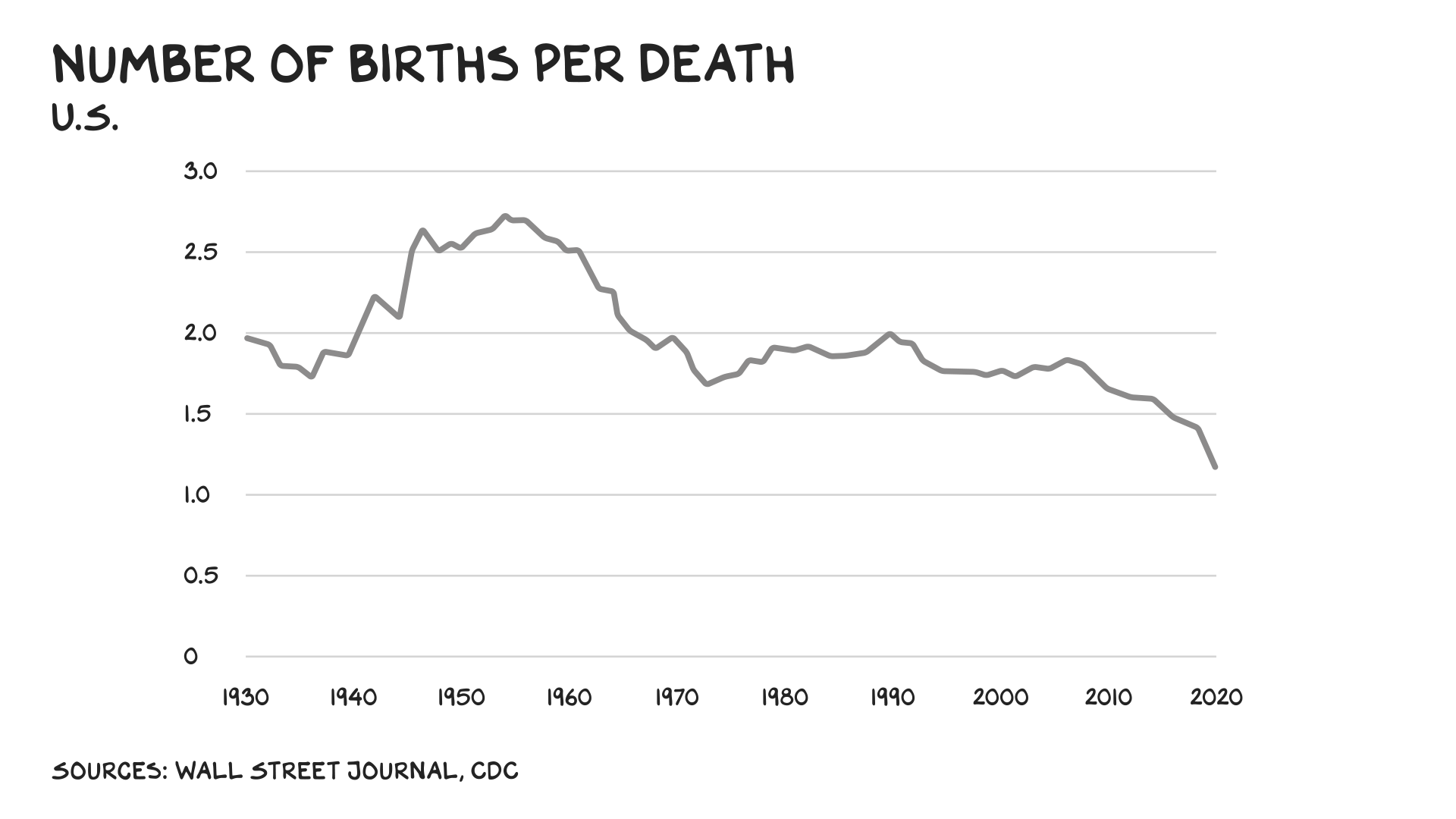
The profound, even existential question is: How do we encourage Gen Z to have kids? For starters, they’re going to have to meet one another, fall in love, and ruin their weekends (i.e., have kids). The issue is that we’re delaying marriage and starting families. Since the early 1970s, the median age for a first marriage has gone from the early 20s to nearly 30.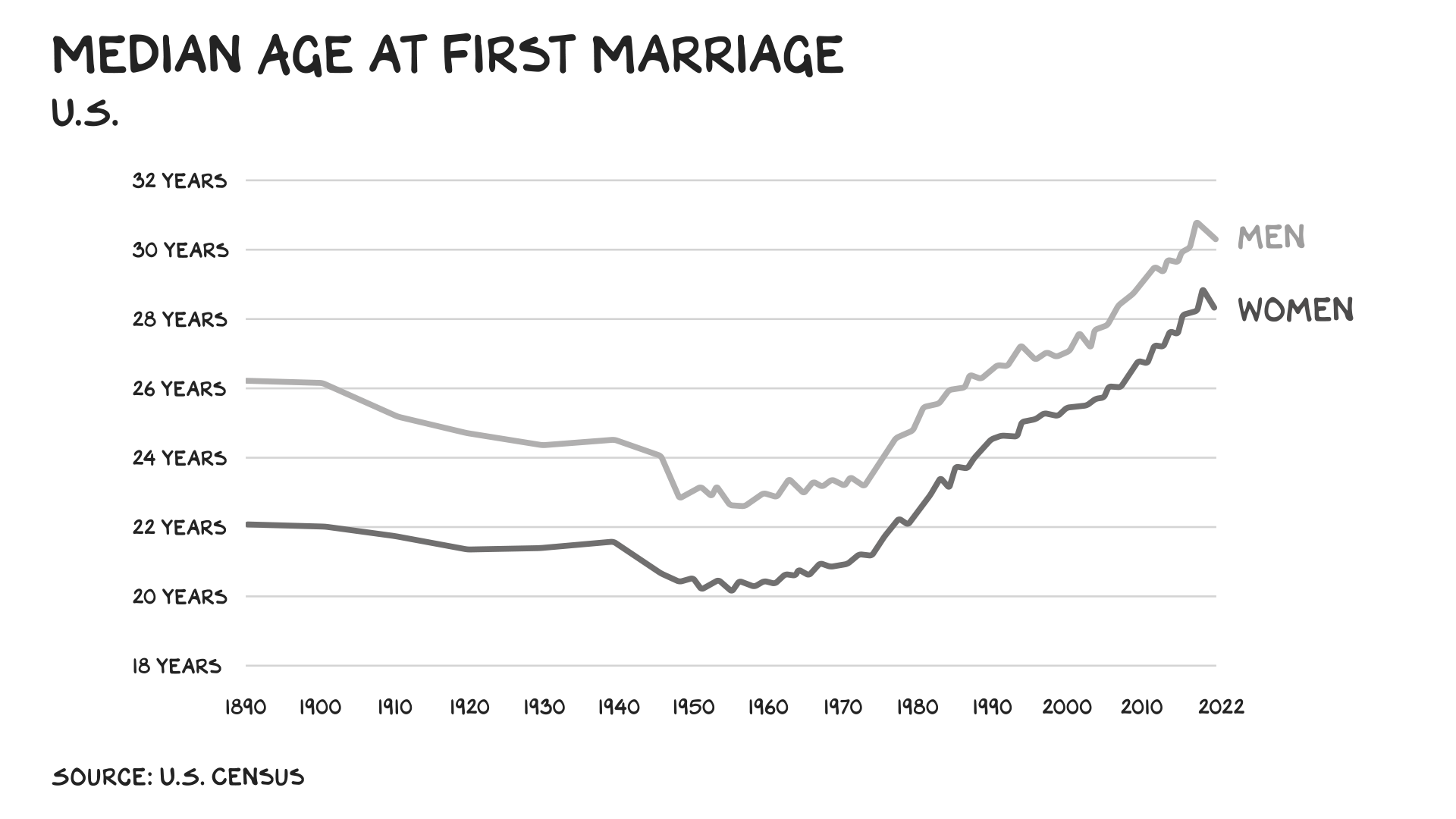
Size Matters
Eighty-four percent of women want a partner taller than them. The problem is, in several dimensions, women are getting taller and men shorter. As we’ve written before, the economic and educational gains of women over the last several decades have had an unintended consequence: Women feel there are fewer worthy men. Women value the financial capacity of a potential partner more than men do: 71% of American women say it’s “very important” for a man to support his family financially. Only 25% of men feel the same about a woman. Over the next five years, we will graduate two women from college for every man.
It’s a vicious cycle. As more women find fewer men to date, the men left behind drift from the dating scene, lose motivation, never gain social skills, and become less attractive. There are solutions: Vocational training programs, an expansion of freshman seats at colleges, and national service would all help “level up” men. We also need more “third places” where people can meet, not just to find romance, but also to build the social networks that lead to strong, durable relationships. Finally, older men need to find the time to engage in young men’s lives, as the absence of a male role model is the strongest predictor of incarceration. Put another way, if we want more men, we need older men to step up.
Creating an environment that encourages the pairing of young people is only half the problem. Our young can increasingly do math, and the math for young people and kids is increasingly ugly. Homebuyers are counseled to keep their house purchase at no more than 2.5 times their annual income, but in many major U.S. cities, spiraling prices have pushed that ratio close to 10 times. Early child care can eat up a third of a working family’s budget. Public schools are struggling in many areas, but the average private high school costs almost $16,000 per year.
If we want more kids, we’re going to have to pay for them. The expansion of the child tax credit, to a maximum $3,600 per child for the poorest families, lifted 3 million children out of poverty in 2021. But we’ve let it lapse. It should not only be renewed, but further expanded. More broadly, we need to reverse the transfer of wealth from the young to the old. Over the past three decades people under the age of 40 have seen their share of wealth cut in half — from 13% to 6%. Taxing current income at higher rates than capital gains is theft from younger people, who make money from sweat, not investments. We have immense wealth in the U.S. — what we lack is progress.
42
I had my first kid at 42. My boys are, by far, my biggest source of stress and sleepless nights. They’ve also given me purpose, and I believe they will steadily become less awful … and maybe help find solutions that help others someday. We need to make a staggering investment in younger generations to provide the means and motivation to have kids. For America, the West, and the species to prosper, we need to get serious about ruining millions of weekends.
Life is so rich,
![]()
P.S. I’m teaching a shorter version of my Brand Strategy Sprint in February: two weeks to learn how to build a sustainable, differentiated, relevant brand. Become a member to sign up. If you want a taste, you can watch the first lesson for free.



